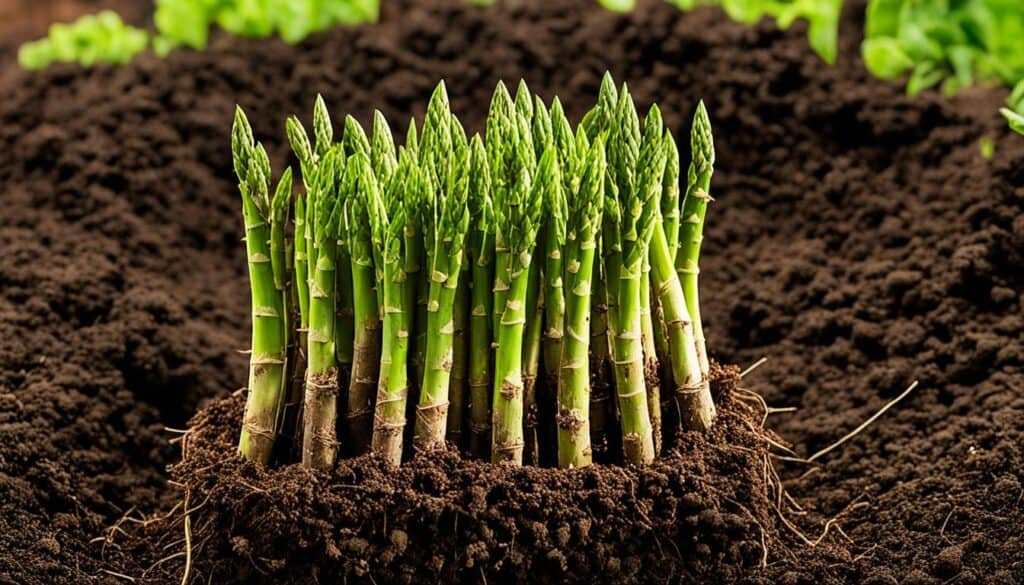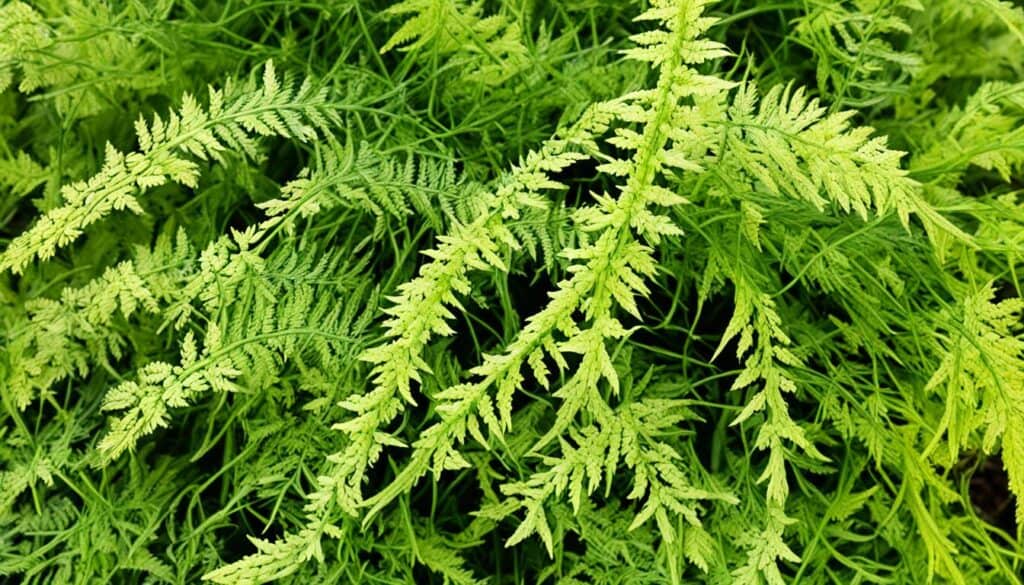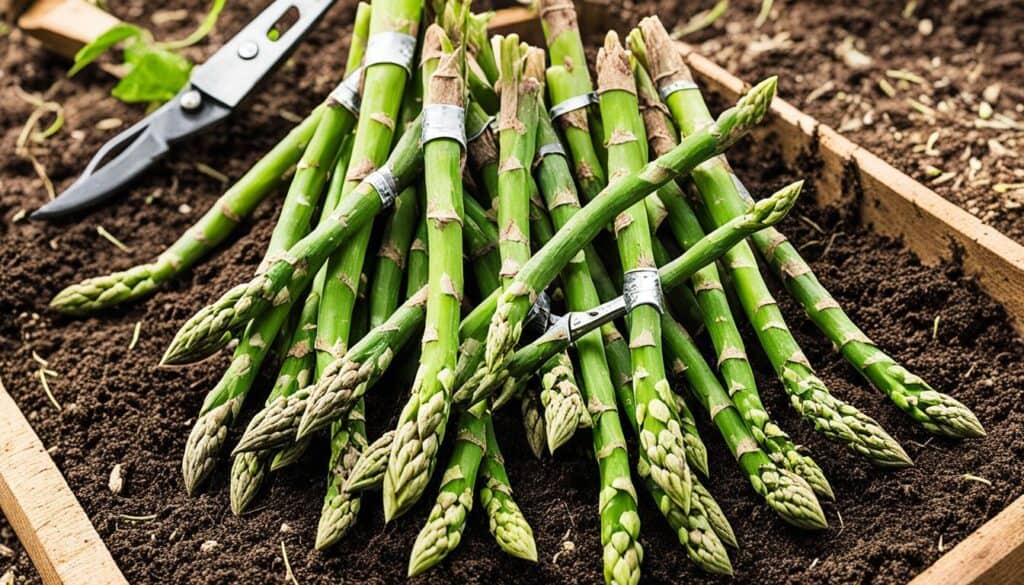Asparagus plants are a fantastic addition to any home garden. Not only do they produce delicious spears that are known for their crispness, tenderness, and flavor, but they also have the incredible ability to thrive for a decade and a half! Whether you’re a seasoned gardener or just starting out, learning the ins and outs of cultivating a healthy asparagus plant is essential.
In this article, I’ll share valuable tips and insights on how to grow asparagus and provide the care it needs to flourish. From selecting the right variety to maintaining soil moisture and harvesting the spears, you’ll discover everything you need to know to ensure your asparagus plants thrive year after year.
Key Takeaways:
- Asparagus plants can live for up to 15 years if cared for properly.
- Proper soil moisture, planting depth, and variety selection are essential for a healthy asparagus plant.
- Asparagus is one of the earliest harvested vegetables in the spring, making it a sign of the season.
- Good soil drainage and a pH between 6.5 to 7.0 are crucial for asparagus plant cultivation.
- Choosing the right asparagus plant variety is important for successful growth and yield.
The Significance of Asparagus in Spring
Asparagus is a delightful vegetable that holds significant importance during the spring season. Its arrival marks the end of winter and the beginning of a fresh and bountiful harvest. The benefits of the asparagus plant extend far beyond its delicious taste, making it a sustainable and valuable addition to your garden.
Asparagus spears are known for their crisp texture, tenderness, and mouthwatering flavor. They are a true delight for culinary enthusiasts and gardeners alike. Did you know that during the peak season, asparagus can grow up to 2 inches per day? This rapid growth ensures gardeners can enjoy a generous harvest throughout the spring months.
Aside from its delectable taste, asparagus is also known for its sustainability. As a perennial vegetable, the asparagus plant can provide harvests for many years with proper care. This sustainability factor makes it an excellent choice for environmentally-conscious gardeners who value long-term cultivation and reduce waste.
“Asparagus is not just a vegetable; it is a symbol of the revitalization and abundance that comes with the arrival of spring.”
The versatile nature of asparagus, its rapid growth, and sustainability contribute to its significance in the spring season. Incorporating asparagus plants into your garden not only ensures a delightful addition to your meals but also allows you to indulge in the joys of sustainable gardening.
Soil Requirements for Asparagus Plant
When it comes to growing healthy asparagus plants, the right soil conditions play a crucial role. Asparagus plants thrive best in well-drained soils with a pH ranging from 6.5 to 7.0. However, they can also tolerate heavy, medium, or sandy soils as long as the drainage is optimal.
If you’re unsure about the quality of your soil, it’s recommended to have it tested before planting the asparagus. A soil test will determine if any nutrient adjustments are necessary for the plant’s growth and development.
Once you have the soil test results, you can make the necessary amendments to create the ideal growing environment. Adding organic matter such as fertilizer, compost, or composted manure can provide the necessary nutrients for healthy asparagus growth. These amendments can be incorporated into the soil before spear emergence or after harvest.
Regular monitoring of the soil conditions is important to ensure that the nutrient levels remain within the recommended range. This will help promote proper growth and overall health of the asparagus plant throughout its lifespan.
“Proper soil conditions are the foundation for a thriving asparagus plant.”
Follow the recommended guidelines for soil preparation and maintenance, and your asparagus plants will reward you with abundant and delicious harvests for years to come.
| Soil Requirement | Optimal Range |
|---|---|
| Soil pH | 6.5 to 7.0 |
| Soil Texture | Heavy, Medium, or Sandy (with good drainage) |
| Soil Amendments | Fertilizer, Compost, Composted Manure |
Soil Requirements Checklist:
- Test soil for pH and nutrient levels
- Adjust pH to 6.5 to 7.0 if needed
- Ensure good soil drainage
- Add organic matter like fertilizer, compost, or composted manure
- Monitor nutrient levels and adjust accordingly
By following these soil requirements and diligently caring for your asparagus plants, you’ll create an optimal growing environment that supports their overall health and productivity.
Selecting the Right Asparagus Plant Variety
When it comes to growing asparagus plants, selecting the right variety is crucial for a successful harvest. With a wide range of asparagus plant varieties available, each with its own unique characteristics and growing preferences, it’s important to do your research and choose carefully. In this section, I’ll highlight some popular asparagus plant varieties and what you need to consider when making your selection.
Male plants are known for producing more spears, making them a popular choice for those looking for a bountiful harvest. On the other hand, female plants can produce weedy seedlings, so they may not be the best option if you’re concerned about controlling unwanted growth.
For gardeners in Minnesota, there are several standout varieties to consider. Millennium, a male hybrid, is known for its high yields and excellent disease resistance. The Jersey series, which includes Jersey Giant, Jersey Knight, and Jersey Supreme, offers a range of options with different spear thickness and spear color. Mary Washington, a classic variety, is widely favored for its good spear quality and productivity.
If you’re looking to add some color to your garden, consider Viking KB-3 and Purple Passion. Viking KB-3 is an early-maturing variety with purple spears, while Purple Passion is known for its vibrant purple color and tender spears.
When choosing an asparagus plant variety, it’s important to consider factors such as your local climate, soil conditions, and personal preferences. Some varieties may perform better in certain regions or soil types, so it’s worth consulting local gardening resources or experts for recommendations based on your specific circumstances.
Planting Guidelines for Asparagus Plant
When it comes to planting asparagus, careful consideration of the planting site is essential. In order to grow healthy asparagus plants, you need to choose a fertile, sunny spot with good soil moisture retention. This will provide the ideal conditions for the asparagus plant to thrive and produce delicious spears.
Avoid planting in areas prone to late spring frosts, as these can kill emerged spears and hinder the growth of your asparagus plant. Additionally, asparagus plants have deep root systems, so it’s important to avoid planting in shallow soils. Deep, well-drained soil will allow the roots to establish and provide stability to the plant.
The planting method for asparagus involves digging a trench and placing the crowns “head-to-toe” inside it. This means the pointed end of the crown (the head) should face upwards, while the root end (the toe) should be placed downwards. Cover the crowns with soil, leaving a slight depression to hold water. As the ferns grow, back-fill the trench gradually, ensuring the crowns are adequately covered.
Remember to provide adequate spacing between the crowns to allow for proper growth and development. Aim for a spacing of 12-18 inches between the crowns and rows.
| Planting Guidelines for Asparagus Plant | |
|---|---|
| Sunlight | Fertile, sunny spot |
| Soil | Well-drained soil with good moisture retention |
| Frost | Avoid late spring frosts |
| Spacing | 12-18 inches between crowns and rows |
“Choosing the right planting site and ensuring proper spacing are crucial for the successful growth of asparagus plants. By providing the right conditions, you’ll be on your way to a bountiful harvest of delicious asparagus spears.”
Maintaining the Health of Asparagus Plant
Consistent soil moisture is crucial for the health and productivity of asparagus plants. They should receive at least one inch of water per week, and additional watering may be necessary during dry periods.
Proper weed management is essential to prevent competition for nutrients and water. Regular inspections of the plants should be carried out to identify any signs of disease or pests.
Asparagus plants are vulnerable to several diseases, including fusarium wilt and asparagus beetles. These diseases can significantly impact the health and yield of the plants.
To combat these issues, proper control measures should be promptly implemented. This may include removing and destroying infected plants, applying organic or chemical treatments, and practicing crop rotation.
Common Asparagus Plant Diseases
The following table summarizes some of the common diseases that can affect asparagus plants:
| Disease | Symptoms | Treatment |
|---|---|---|
| Fusarium Wilt | Yellow or brown discoloration of the foliage, wilting, stunting of growth | Remove and destroy infected plants, practice crop rotation, apply fungicides |
| Asparagus Beetle | Black and yellow beetles, eggs on the foliage, skeletonized leaves | Handpick beetles, remove eggs, apply insecticides as necessary |
Implementing a comprehensive integrated pest management strategy is essential to keep asparagus plants healthy and productive. This includes regular monitoring, proper sanitation, and timely intervention when necessary.
Harvesting the Spears of Asparagus Plant
Harvesting asparagus spears is an exciting part of growing your own asparagus plant. However, it’s important to exercise patience, as these plants need time to establish their root systems before harvest. For optimal results, harvesting should not begin until the third year after planting crowns.
So, when is the right time to harvest your asparagus spears? Once they reach a height of 8 to 10 inches and a thickness of 1/2 to 3/4 inch, they are ready to be picked. To ensure the best quality and flavor, it’s recommended to harvest them when they are still tight and before they start to unfurl.
When harvesting asparagus spears, it’s essential to use the proper technique. Cut the spears at ground level using a sharp knife or a pair of scissors. Be careful not to damage emerging shoots that haven’t yet emerged, as these will grow into future spears. It’s crucial to leave some spears on the plant to allow for proper fern growth, which will help store energy for next year’s harvest.
If you’re unsure about whether a spear is ready to be harvested, a good rule of thumb is to wait until it is thicker than a pencil. This ensures that the spear has had enough time to develop and will offer the best eating experience.
Remember not to over-harvest your asparagus plant. By allowing some spears to grow into ferns, you’re giving the plant the opportunity to recharge and strengthen its root system, ensuring a healthier and more productive crop in the future.
| Harvesting Tips | Do’s | Don’ts |
|---|---|---|
| Start harvesting in the third year | Harvest spears when they reach 8-10 inches in height and 1/2-3/4 inch thick | Over-harvest |
| Use a sharp knife or scissors | Allow some spears to grow into ferns for future growth | Damage emerging shoots |
By following these guidelines, you can enjoy the fruits of your labor and savor the delicious taste of homegrown asparagus. Remember to handle the spears with care and store them properly to maintain their freshness and quality.
Overwintering and Pruning Asparagus Plant
During the winter months, proper care is essential to ensure the health and productivity of asparagus plants. Pruning and removing dead foliage in late fall or winter before new growth starts is a crucial step. This not only helps prevent pests from overwintering in the stalks but also promotes overall plant health.
In addition to pruning, there are other measures you can take to protect your asparagus plants during the winter. Side-dressing the bed with compost and mulching can help insulate the crowns and retain soil moisture, safeguarding the plants from harsh winter conditions.
Proper pruning techniques should be followed to ensure the best results. Remove the dead foliage, being careful not to damage the emerging shoots. Cut the stalks at ground level using a sharp knife or scissors.
By providing the necessary care and maintenance during the winter, you are setting the stage for a successful growing season. The asparagus plants will emerge strong and healthy, ready to produce a bountiful harvest.
Conclusion
Growing a healthy asparagus plant requires careful planning and attention to detail. By following the proper asparagus plant cultivation techniques, you can enjoy a bountiful harvest of delicious spears for many years to come.
Start by selecting the right variety for your garden, considering factors such as spear production and growth preferences. Plant the crowns in a fertile, sunny spot with well-drained soil to ensure optimal growth. Remember to provide consistent soil moisture and monitor for any potential diseases or pests that may affect the health of your plants.
With patience and consistent care, your asparagus plants will reward you with tender and flavorful spears each spring. Whether you’re a seasoned gardener or a beginner, adding asparagus to your garden can be a rewarding and sustainable choice.










Leave a Reply